Zhuang language
| Zhuang | ||
|---|---|---|
| Vahcuengh/Vaьcueŋь | ||
| Spoken in | ||
| Total speakers | 14 million | |
| Language family | Kradai
|
|
| Language codes | ||
| ISO 639-1 | za | |
| ISO 639-2 | zha | |
| ISO 639-3 | variously: zha – Zhuang (generic) zch – Central Hongshuihe Zhuang zhd – Dai Zhuang zeh – Eastern Hongshuihe Zhuang zgb – Guibei Zhuang zgn – Guibian Zhuang zln – Lianshan Zhuang zlj – Liujiang Zhuang zlq – Liuqian Zhuang zgm – Minz Zhuang zhn – Nong Zhuang zqe – Qiubei Zhuang zyg – Yang Zhuang zyb – Yongbei Zhuang zyn – Yongnan Zhuang zyj – Youjiang Zhuang zzj – Zuojiang Zhuang |
|
| Linguasphere | ||
| Note: This page may contain IPA phonetic symbols in Unicode. | ||

The Zhuang language (autonym: Vahcuengh/Vaьcueŋь("Vah/Vaь" means language and "cuengh/cueŋь" means Zhuang); simplified Chinese: 壮语; traditional Chinese: 壯語; pinyin: Zhuàngyǔ) is a language from the Tai language group used by the Zhuang people. Most speakers live in the Guangxi Zhuang Autonomous Region within the People's Republic of China, where it is an official language.
Standardized Zhuang is based on the dialect of Wuming County. The Buyei language is a slightly different standard form of Zhuang used across the provincial border in Guizhou. There is a dialect continuum between Zhuang and Buyei.
Contents |
Phonology
Zhuang is a tonal language. It has six tones in open syllables:
| Number | Contour | Description |
|---|---|---|
| 1 | ˨˦ | rising |
| 2 | ˧˩ | low falling |
| 3 | ˥ | high level |
| 4 | ˦˨ | falling |
| 5 | ˧˥ | high rising |
| 6 | ˧ | mid level |
It has two (high and low) in closed syllables.
Writing systems
Zhuang has been written with logographs called sawndip; some are borrowed directly from Han characters adopted to this language, and some original characters made up by using the similar manner of construction, for more than a thousand years, rather like Vietnamese Chữ nôm. Sawndip are used for writing songs about every aspect of life, including in more recent times encouraging people to follow official family planning policy.
In 1957, in the People's Republic of China, a Latin alphabet with some special letters was introduced to write the new standardised Zhuang language. A spelling reform in 1982 replaced these special letters with regular letters of the Latin alphabet to facilitate printing and the use of computers.[1]
The tables below compare spelling before and after the 1982 reform.
|
|
|||||||||||||||||||||||||||||||||||||||||||||||||||||||||||||||||||||||||||||||||||||||||||||||||||||||||||||||||||||||||||||||||||||||||||||||
Example
First article of the Declaration of Human Rights.
| 1957 | 1982 | English |
|---|---|---|
| Bouч bouч ma dəŋƨ laзƃɯn couƅ miƨ cɯyouƨ, cinƅyenƨ cəuƽ genƨli bouчbouч biŋƨdəŋз. Gyoeŋƽ vunƨ miƨ liзsiŋ cəuƽ lieŋƨsim, ɯŋdaŋ daiƅ gyoengƽ de lumз beiчnueŋч ityieŋƅ. | Boux boux ma daengz lajmbwn couh miz cwyouz, cinhyenz caeuq genzli bouxboux bingzdaengj. Gyoengq vunz miz lijsing caeuq liengzsim, wngdang daih gyoengq de lumj beixnuengx ityiengh. | All human beings are born free and equal in dignity and rights. They are endowed with reason and conscience and should act towards one another in a spirit of brotherhood. |
See also
- Zhuang people
- Zhuang logogram
- Languages of China
Notes
- ↑ Minglang Zhou: Multilingualism in China: the politics of writing reforms for minority languages 1949-2002 (Berlin, Mouton de Gruyter 2003), ISBN 3-11-017896-6, p. 251–258.
Bibliography
- Wéi Qìngwěn 韦庆稳, Tán Guóshēng 覃国生: Zhuàngyǔ jiǎnzhì 壮语简志 (Beijing, Mínzú chūbǎnshè 民族出版社 1980).
- Tán Xiǎoháng 覃晓航: Xiàndài Zhuàngyǔ 现代壮语 (Beijing, Mínzú chūbǎnshè 民族出版社 1995).
- Tán Guóshēng 覃国生: Zhuàngyǔ fāngyán gàilùn 壮语方言概论 (Nanning, Guǎngxī mínzú chūbǎnshè 广西民族出版社 1996).
- Zhuàng-Hàn cíhuì 壮汉词汇 (Nanning, Guǎngxī mínzú chūbǎnshè广西民族出版社 1984).
External links
- Zhuang language at Ethnologue
- Unicode Latin Extended-B code chart specifies the Unicode characters to be used for the Zhuang special letters
- Zhuang language & alphabet, Omniglot
- Introduction to sawndip, mentions both ancient and modern usages, at the Chinese Academy of Social Science in Beijing
- The prospects for the long-term survival of Non-Han minority languages in the south of China
- Part 1 The study of the Zhuang language, Institute of Zhuang Language and Culture
- Ningming Zhuang Numbers from one to ten, Institute of Zhuang Language and Culture
- Field Notes on the Pronominal System of Zhuang "A major case of language shift is occurring in which the use of Zhuang and other minority languages is restricted mainly to rural areas because Zhuang-speaking villages, like Jingxi, which develop into towns become more and more of Mandarin-speaking towns. Zhuang-speaking villages become non-Zhuang-speaking towns! And children of Zhuang-speaking parents in cities are likely not to speak Zhuang as a mother-tongue."